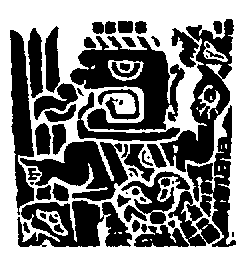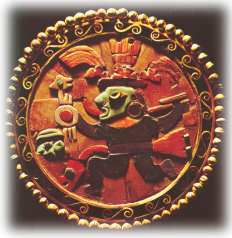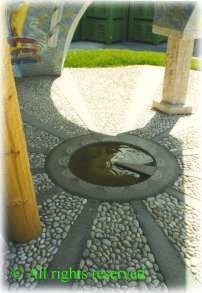|
he archaeologic site is
situated to the south of lake Titicaca, in Bolivian territory belonging to
Aymara-speaking ethnic groups. For this reason the term "Tiwanaku" is used
in preference to "Tiahuanaco", the latter coming from the Quechua language.
An iconographic study of the pre-Inca civilisation of Tiwanaku IV,
reveals in the figurative complex carved in bas-relief on the frontal of the Gateway of
the Sun, an ideographic system that describes with astronomical precision the course of
the Annual Solar Cycle. The interpretative hypothesis for the ideograms in bas-relief
identifies a geometric system of time measurement in the figurative representation of the
Annual Solar Cycle. |
|
|
he ideographic images, relating to the astronomical periods of the
Solar Cycle, represent not only the Calendar but also the structure of the hierarchical
organization of the State.
We may well be concerned have with the same social order
of the Inca civilisation, theorized by the ethnologist R. T. Zuidema, in
his studies on the Cheque system of Cuzco (Qosqo) and on the
Collana, Payan and Cayao groups.

| Falcon-Man. Chavin de Huantar |
|
The research involves the following fields of study: Archaeology,
Cultural Ethnology and Anthropology, Linguistic and Archaeoastronomy. It is also within
the bounds of these disciplines that the verification of the interpretative
hypothesis must proceed.The study reconstructs the original description of fundamental elements
of the pre-Inca culture of Tiwanaku IV, only slight traces of which subsisted in the 16th
and 17th century Spanish chronicle on the Inca civilisation. Taking into account the
results of this research, in the context of the historical reconstructions of the pre-Inca
and Inca Andean civilisation, may clarify the probable causes of the absence
of system of writing or the failure of these to develop. |
|
|
he concept derived from this study, that of "geometrizing"
of the Solar Cycle, may be a particularly useful line of enquiry into
many other ancient prehistoric cultures.

| Mochica jewel. (gold and turquoise) |
|
It may explain how informations on celestial calculations was
recorded and complex astronomical knowledge was transmitted, by being inserted in
the enormous architectonics and planimetric Structures, still to be seen today
in various parts of the world. |
|
THE ANCIENT GEOMETRIC MEASURE OF TIME IN TIWANAKU.
THE KEPLER'S
KINEMATIC SECOND LAW
AND THE PROPORTIONAL CLOCK.
he scientific reliability of this research finds indirect confirmation
on the clock dial, since all system of time measurement in fact refers to the solar cycle,
that is to say to mathematical and geometrical parameters that describe the terrestrial
orbit.

The Proportional Clock
© All rights reserved. |
|
Thus, by applying Kepler's second kinematic law to the
hours circle, we arrive at a geometric system for the figurative representation of time
known as the "Proportional Dial".
The "Proportional Clock" derives in turn from
this dial and incorporates a new figurative dimension of time in Architecture
and Urban planning.
The picture on the right shows an example of Urban
furnishing with a Proportional Clock,
sculpted in porphyry, white river stone and water, by Cesare Berrini for a cooperative
wine-growers association in the Trentino. |
|
|
he research on the ideographic system of the Gateway of the Sun of
Tiwanaku and the Proportional Clock was presented, in winter of 1995 - 1996, at the
Museo Tridentino di Scienze Naturali (Tridentino Museum of Natural Sciences) in
an exibition entitled " Geometrie del Tempo " (Geometries
of Time); sponsored by FeCCriT and PROMART of Trento.
The results of
this study have also been cited by the peruvian sociologist Victor Campero in his essay:
Tawantinsuyo: Gli Incas. Civiltą scomparsa o etnia sottomessa? (Tawantinsuyo: The
Incas. Lost civilisation or subject people?)
CONTACTS PRIORITY
About the ideographic system: University and Researchers
About the Proportional Clock: Architects and City-planners |
Publication by A.A.T. courtesy. (Associazione Astrofili Trentini)
|
|
[Top of the page] |


